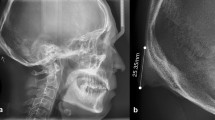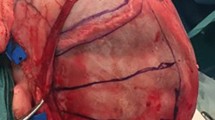Abstract
Objective
To evaluate the presence of occipital spurs, morphologic/morphometric features, and the presence of ossification of ligamentum nuchae (ONL) on lateral cephalometric radiographs of individuals aged under and over 18 years.
Methods
Lateral cephalometric radiographs of 1430 individuals aged between 14–50 years were scanned. The presence of ONL and occipital spurs was evaluated in 1312 patients who met the inclusion criteria, and existing occipital spurs were measured and their types (flat/crest/spine) were recorded.
Results
Occipital spurs were detected in 63 patients aged over 18 years (63/120; 52.5%) and 57 patients aged under 18 years (57/120; 47.5%). When the spur length by age category and sex was evaluated, no statistically significant difference was observed. The spur types seen were flat (40.8%; 49/120), crest (30%; 36/120) and spine (29.2%; 35/120), respectively. Although there was no statistically significant difference between the spur types seen in terms of age, a significant difference was observed between the sexes in the total group (p < 0.001). Spine-type spurs (66.7%; 18/27) were the most common in females, and flat-type spurs (45.2%; 42/39) were the most common in males. ONL was detected in only three individuals.
Conclusion
No relationship was found between the presence of occipital spurs and ONL. Although spur length was not affected by age and sex, spur types were found to vary according to sex. Occipital spurs are mostly asymptomatic and detected incidentally on lateral cephalometric radiographs. They are one of the important anatomic formations that should be diagnosed by physicians.



Similar content being viewed by others
Availability of data and material
Not applicable.
Code availability
Not applicable.
Change history
25 May 2022
A Correction to this paper has been published: https://doi.org/10.1007/s11282-022-00623-0
References
Porrino J, Sunku P, Wang A, Haims A, Richardson ML. Focus: preventive medicine: exophytic external occipital protuberance prevalence pre-and post-iPhone introduction: a retrospective cohort. Yale J Biol Med. 2021;94(1):65.
Shahar D, Sayers MG. A morphological adaptation? The prevalence of enlarged external occipital protuberance in young adults. J Anat. 2016;229(2):286–91.
Srivastava M, Asghar A, Srivastava NN, Gupta N, Jain A, Verma J. An anatomic morphological study of occipital spurs in human skulls. J Craniofac Surg. 2018;29(1):217–9.
Jacques T, Jaouen A, Kuchcinski G, Badr S, Demondion X, Cotten A. Enlarged external occipital protuberance in young french individuals’ head ct: stability in prevalence, size and type between 2011 and 2019. Sci Rep. 2020;10(1):1–9.
Shahar D, Sayers MG. Prominent exostosis projecting from the occipital squama more substantial and prevalent in young adult than older age groups. Sci Rep. 2018;8(1):1–7.
Gulekon IN, Turgut HB. The external occipital protuberance: can it be used as a criterion in the determination of sex? J Forensic Sci. 2003;48(3):513–6.
Varghese E, Samson RS, Kumbargere SN, Pothen M. Occipital spur: understanding a normal yet symptomatic variant from orthodontic diagnostic lateral cephalogram. Case Rep. 2017;2017:bcr-2017-220506.
Mercer SR, Bogduk N. Clinical anatomy of ligamentum nuchae. Clin Anat. 2003;16(6):484–93.
Takeshita K, Peterson ET, Bylski-Austrow D, Crawford AH, Nakamura K. The nuchal ligament restrains cervical spine flexion. Spine. 2004;29(18):E388–93.
Johnson GM, Zhang M, Jones DG. The fine connective tissue architecture of the human ligamentum nuchae. Spine. 2000;25(1):5.
Chazal J, Tanguy A, Bourges M, Gaurel G, Escande G, Guillot M, et al. Biomechanical properties of spinal ligaments and a histological study of the supraspinal ligament in traction. J Biomech. 1985;18(3):167–76.
Cheng S. The relation between the injury of nuchal ligament and cervical spondylosis. Spinal Surg. 2004;2:241–2.
Luo J, Wei X, Li JJ. Clinical significance of nuchal ligament calcification and the discussion on biomechanics. Zhongguo gu shang China J Orthopaed Traumatol. 2010;23(4):305–7.
Niepel GA, Sit’aj Š. 9—Enthesopathy. Clin Rheum Dis. 1979;5(3):857–72.
Shaibani A, Workman R, Rothschild BM. The significance of enthesopathy as a skeletal phenomenon. Clin Exp Rheumatol. 1993;11(4):399–403.
Claudepierre P, Voisin MC. The entheses: histology, pathology, and pathophysiology. Joint Bone Spine. 2005;72(1):32–7.
Boden SD, Davis DO, Dina TS, Patronas NJ, Wiesel SW. Abnormal magnetic-resonance scans of the lumbar spine in asymptomatic subjects. A prospective investigation. J Bone Joint Surg Am. 1990;72(3):403–8.
Matsumoto M, Okada E, Ichihara D, Watanabe K, Chiba K, Toyama Y, et al. Age-related changes of thoracic and cervical intervertebral discs in asymptomatic subjects. Spine. 2010;35(14):1359–64.
Singh R. Bony tubercle at external occipital protuberance and prominent ridges. J Craniofac Surg. 2012;23(6):1873–4.
Durbar US. Racial variations in different skulls. J Pharm Sci Res. 2014;6(11):370.
Wood-Jones F. The non-metrical morphological characters of the skull as criteria for racial diagnosis: part IV. The non-metrical morphological characters of the northern Chinese skull. J Anat. 1933;68(1):96–108.
Vasanth D, Ramesh N, Fathima FN, Fernandez R, Jennifer S, Joseph B. Prevalence, pattern, and factors associated with work-related musculoskeletal disorders among pluckers in a tea plantation in Tamil Nadu, India. Indian J Occup Environ Med. 2015;19(3):167.
Shingyouchi Y, Nagahama A, Niida M. Ligamentous ossification of the cervical spine in the late middle-aged Japanese men: its relation to body mass index and glucose metabolism. Spine. 1996;21(21):2474–8.
Mine T, Kawai S. Ultrastructural observations on the ossification of the supraspinous ligament. Spine. 1995;20(3):297–302.
Funding
This research did not receive any specific grant from funding agencies in the public, commercial, or not-for-profit sectors.
Author information
Authors and Affiliations
Contributions
DNG: Conceptualization, Resources, Writing—original draft; TEK: Resources, Writing—original draft; MG: Writing—review & editing.
Corresponding author
Ethics declarations
Conflict of interest
The authors deny any conflicts of interest related to this study.
Ethical statement
The study design was approved by the Ethics Committee of the Recep Tayyip Erdogan University Faculty of Medicine.
Consent to participate
Informed consent was obtained from all individual participants included in the study.
Consent for publication
Patients signed informed consent regarding publishing their data and photographs.
Additional information
Publisher's Note
Springer Nature remains neutral with regard to jurisdictional claims in published maps and institutional affiliations.
Rights and permissions
About this article
Cite this article
Gunacar, D.N., Gonca, M. & Kose, T.E. Occipital spurs on lateral cephalometric radiographs: morphologic and morphometric features. Oral Radiol 38, 416–421 (2022). https://doi.org/10.1007/s11282-021-00574-y
Received:
Accepted:
Published:
Issue Date:
DOI: https://doi.org/10.1007/s11282-021-00574-y




